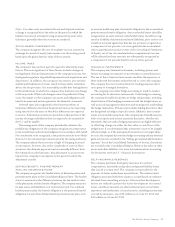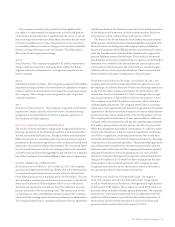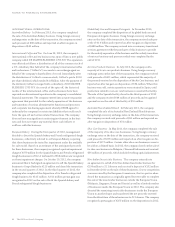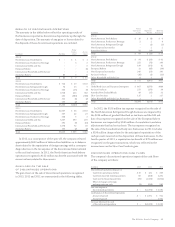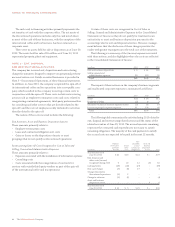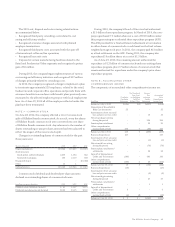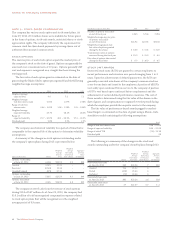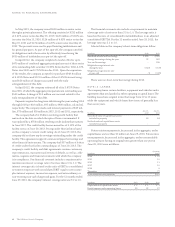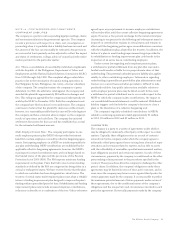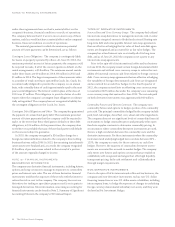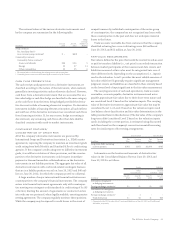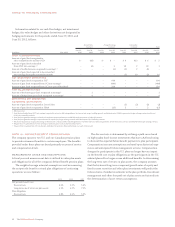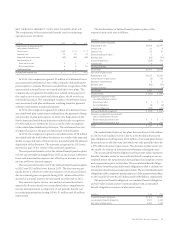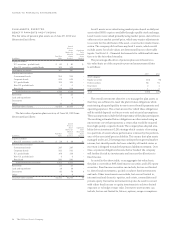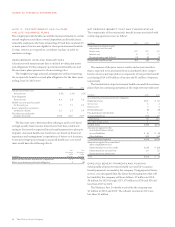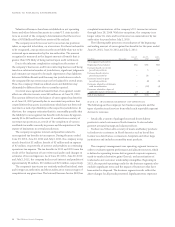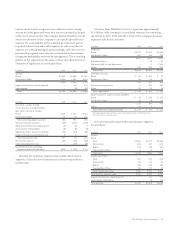Sara Lee 2013 Annual Report Download - page 51
Download and view the complete annual report
Please find page 51 of the 2013 Sara Lee annual report below. You can navigate through the pages in the report by either clicking on the pages listed below, or by using the keyword search tool below to find specific information within the annual report.The Hillshire Brands Company 49
NOTE 14 – CONTINGENCIES AND COMMITMENTS
CONTINGENT LIABILITIES
The company is a party to various pending legal proceedings, claims
and environmental actions by government agencies. The company
records a provision with respect to a claim, suit, investigation or
proceeding when it is probable that a liability has been incurred and
the amount of the loss can reasonably be estimated. Any provisions
are reviewed at least quarterly and are adjusted to reflect the impact
and status of settlements, rulings, advice of counsel and other infor-
mation pertinent to the particular matter.
Aris This is a consolidation of cases filed by individual complainants
with the Republic of the Philippines, Department of Labor and
Employment and the National Labor Relations Commission (NLRC)
from 1998 through July 1999. The complaint alleges unfair labor
practices due to the termination of manufacturing operations in
the Philippines by Aris Philippines, Inc. (Aris), a former subsidiary
of the company. The complaint names the company as a party
defendant. In 2006, the arbitrator ruled against the company and
awarded the plaintiffs approximately $80 million in damages and
fees. This ruling was appealed by the company and subsequently set
aside by the NLRC in December 2006. Both the complainants and
the company have filed motions for reconsideration. The company
continues to believe that the plaintiffs’ claims are without merit;
however, it is reasonably possible that this case will be ruled against
the company and have a material adverse impact on the company’s
results of operations and cash flows. The company has initiated
settlement discussions for this case and has established an accrual
for the estimated settlement amount.
Multi-Employer Pension Plans The company participates in one
multi-employer pension plan (MEPP) that provided retirement
benefits to certain employees covered by collective bargaining agree-
ments. Participating employers in a MEPP are jointly responsible for
any plan underfunding. MEPP contributions are established by the
applicable collective bargaining agreements; however, the MEPPs
may impose increased contribution rates and surcharges based on
the funded status of the plan and the provisions of the Pension
Protection Act of 2006 (PPA). The PPA imposes minimum funding
requirements on the plans. Plans that fail to meet certain funding
standards as defined by the PPA are categorized as being either in a
critical or endangered status. We have received notice that the plan
to which we contribute has been designated in critical status. The
trustees of critical status multi-employer plans must adopt a rehabili-
tation or funding improvement plan designed to improve the plan’s
funding within a prescribed period of time. Rehabilitation and funding
improvement plans may include increased employer contributions,
reductions in benefits or a combination of the two. Unless otherwise
agreed upon, any requirement to increase employer contributions
will not take effect until the current collective bargaining agreements
expire. However, a five percent surcharge for the initial critical year
(increasing to ten percent for the following and subsequent years) is
imposed on contributions to plans in critical status and remains in
effect until the bargaining parties agree on modifications consistent
with the rehabilitation plan adopted by the trustees. In addition, the
failure of a plan to meet funding improvement targets provided in
its rehabilitation or funding improvement plan could result in the
imposition of an excise tax on contributing employers.
Under current law regarding multi-employer pension plans,
a withdrawal or partial withdrawal from any plan that was under-
funded would render us liable for our proportionate share of that
underfunding. This potential unfunded pension liability also applies
ratably to other contributing employers. Information regarding
underfunding is generally not provided by plan administrators and
trustees on a current basis and when provided, is difficult to inde-
pendently validate. Any public information available relative to
multi-employer pension plans may be dated as well. In the event
a withdrawal or partial withdrawal was to occur with respect to the
MEPP to which the company makes contributions, the impact to
our consolidated financial statements could be material. Withdrawal
liability triggers could include the company’s decision to close a
plant or the dissolution of a collective bargaining unit.
The company’s regularly scheduled contributions to MEPPs
related to continuing operations totaled approximately $1 million
in 2013, $2 million in 2012 and $3 million in 2011.
GUARANTEES
The company is a party to a variety of agreements under which it
may be obligated to indemnify a third party with respect to certain
matters. Typically, these obligations arise as a result of contracts
entered into by the company under which the company agrees to
indemnify a third party against losses arising from a breach of repre-
sentations and covenants related to matters such as title to assets
sold, the collectibility of receivables, specified environmental matters,
lease obligations assumed and certain tax matters. In each of these
circumstances, payment by the company is conditioned on the other
party making a claim pursuant to the procedures specified in the
contract. These procedures allow the company to challenge the other
party’s claims. In addition, the company’s obligations under these
agreements may be limited in terms of time and/or amount, and in
some cases the company may have recourse against third parties for
certain payments made by the company. It is not possible to predict
the maximum potential amount of future payments under certain of
these agreements, due to the conditional nature of the company’s
obligations and the unique facts and circumstances involved in each
particular agreement. Historically, payments made by the company


